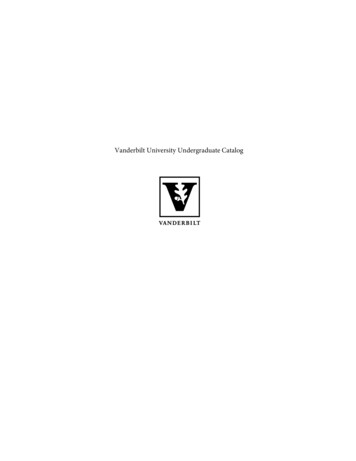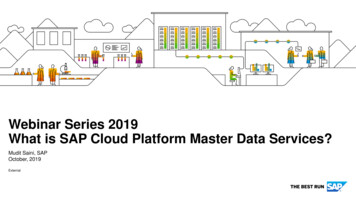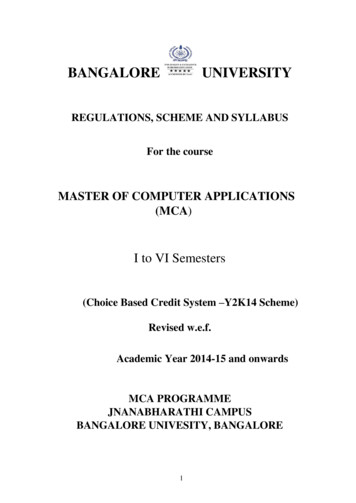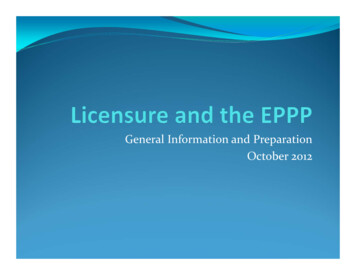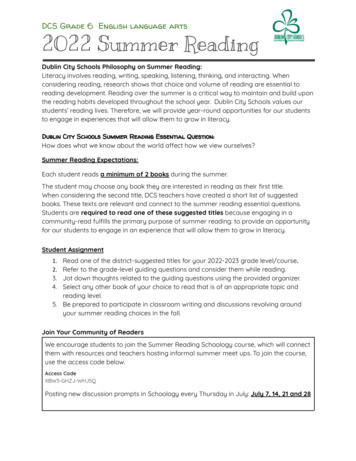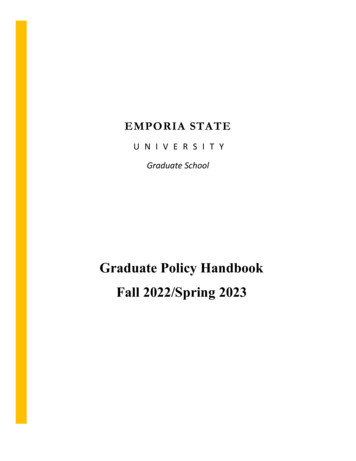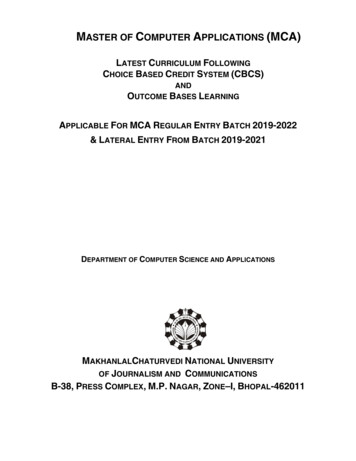
Transcription
MASTER OF COMPUTER APPLICATIONS (MCA)LATEST CURRICULUM FOLLOWINGCHOICE BASED CREDIT SYSTEM (CBCS)ANDOUTCOME BASES LEARNINGAPPLICABLE FOR MCA REGULAR ENTRY BATCH 2019-2022& LATERAL ENTRY FROM BATCH 2019-2021DEPARTMENT OF COMPUTER SCIENCE AND APPLICATIONSMAKHANLALCHATURVEDI NATIONAL UNIVERSITYOF JOURNALISM AND COMMUNICATIONSB-38, PRESS COMPLEX, M.P. NAGAR, ZONE–I, BHOPAL-462011
About the Department of Computer Science & ApplicationsThe Department of Computer Science and Applications was established in the year 1993 with the aim ofdeveloping professionals in main stream of Computer Science and Applications.The Department offers PhD and postgraduate degree courses through UTD. The Department studies market trendsand new developments in the area, conducts massive brainstorming with leading academia and industryprofessionals to develop the curricula.The Department is committed to provide excellence in teaching. It has a rich knowledge pool of well-trained facultyand a modern computer lab enabled to impart all required knowledge, a long with its own library with latest bookson various advanced areas in computers. Regular hands-on workshops are conducted to update students with thelatest technology.Many of the alumni are working in top companies including IBM, MicroSoft, American Express Bank, Wipro,Infosys, Samsung, Microsoft, WorldPay, CISCO, HCL, Jindal, Web Dunia and more in India as well as abroad,apart from few also being entrepreneurs and some other, in academics with prestigious institutions.About The Masters of Computer Application (MCA) ProgramMaster of Computer Applications (MCA) is a three/ two years post graduate programme. The curriculum of MCA isdesigned to meet the growing demand of qualified professionals in the field of ICT. It comprises of the core subjectslike database, networking, data structure, core programmeming languages like C, C ,.NET and Java. Studentsalso get exposure to advanced topics like cyber security, mobile software, IOT, data science etc. Elective papershelp students to have an exposure in Cloud Computing, Big Data and Information Security related subjects.Regular Entry Mode:Level - PostgraduateDuration - MCA - 3 years (6 semesters) Seats - 60Eligibility Criteria - Graduate degree from recognised University with minimum 50% marks, and must have studiedmathematics at Graduation or Senior Secondary level.Approved by : AICTELateral Entry Mode:Level - PostgraduateDuration - 2 years (4 semesters)Seats - 35Eligibility Criteria- BCA, B.Sc. (IT/Comp. Sc.) from recognised University with minimum 50% marks (45% for SC/ST) at graduate level. Must have Mathematics at 10 2 level or at Graduate Level.Approved by : AICTEProgram ObjectivesTo empower students with basic skills of various technologies.To develop the ability to identify, analyse, formulate and develop computer applications.To enable the students to select modern computing tools and techniques and use them with dexterity.If you are looking for challenging roles in the IT industry, computer science research, web and mobile development,data analysis, information security etc., this programme is for you.Career Path after Completing the Programme Software DeveloperProgrammerSystems AnalystComputer Support EngineerDatabase AdministratorSystems AdministratorWeb Designer & Developer Network Administrator
MakhanlalChaturvedi National University of Journalism &Communication, BhopalMCA &MCA (Lateral Entry) CBCS Scheme July 2019SemesterCore Courses(Compulsory)4 Papers of 5 Credits2 labs of 2CreditsPrinciples of ProgrammingLanguagesIDigital Organization(RegularProgramming in CEntry)Office Automation Using PCPackageNumerical MethodsObject Oriented ProgrammingIIwith C Database Management SystemsNetworked Knowledge SocietyWeb TechnologiesData Structures and AlgorithmIIIAdvance DBMS(LateralOperating SystemsEntry)IVVC Programming Multimedia ApplicationsLabE-Commerce andOfficeE-GovernanceAutomationLabC LabDBMS LabData StructureLabLinux LabJava ProgrammingComputer NetworksCloud ComputingData Mining and BusinessIntelligenceSoftware EngineeringJavaProgrammingLabIoTLabDot Net LabMobileDot Net TechnologyApplicationInformation and Network e learningProject Analysis & PlanningVIProject Design & Development(Major Project Testing & ValidationProject) Project DocumentationProject Presentation & VivaCore Courses (Elective)Choose 1 Paper of 5Credits&Communicative EnglishInformation SystemAnalysis and DesignDiscrete MathematicsProfessionalCommunication SkillsMicroprocessor andAssembly LanguageProgrammingComputer GraphicsTheory of ComputationManagement Theory &PracticesCompiler DesignBig Data AnalyticsLinux ServerAdministrationOpen ElectivesChoose 1 Paper of 3Credits FromUniversity OpenElectives for PG inEach SemesterAdvanced ExcelOracle and SQLProgrammingPythonProgrammingAngular JavaScriptProgrammingwith RSoftware Testingand QualityAssuranceCyber Crime &LawsSoft ComputingMATLABProgramming
Semester ISubjectCode1MCA1Subject NameLTPrinciples of Programming50Languages1MCA2Digital Organization501MCA3Programming in C501MCA4Office Automation Using PC50Package1MCA5(P) C Programming Lab001MCA6(P) Office Automation Lab00Elective1MCA7(A) Multimedia Applications501MCA7(B) E-Commerce andE-GovernanceOpen ElectiveSemester Total Marks and 100442200101040405050058020010033250650Semester lective2MCA7(A)2MCA7(B)Key :Instructions:Subject NameLTPInternalMarks20PracticalMarks0Numerical MethodsObject Oriented Programmingwith C Database ManagementSystemsNetworked KnowledgeSocietyC LabDBMS 200101040405050580200100Communicative English500Information System Analysisand DesignOpen ElectiveSemester Total Credits and MarksCreditsTheoryMarks80TotalMarks100332L-Lecture hours, T- Tutorial hours , P-Practical hours, C-CreditsFor passing the subject examination minimum 40% marks must be separately scored in Theory Paper,Practical Exams and Internal Evaluation for the subject.Please refer concerned regulation for details50650
Semester IIISubjectCode3MCA13MCA2Subject NameLTPCreditsWeb TechnologiesData Structures andAlgorithmAdvance DBMSOperating SystemsData Structure LabLinux 100505005802001003MCA35 03MCA45 03MCA5(P)0 03MCA6(P)0 0Elective3MCA7(A) Discrete MathematicsProfessional Communication5 03MCA7(B) SkillsMicroprocessor and Assembly3MCA7(C) Language ProgrammingOpen ElectiveSemester Total Credits and 2TotalMarks10050650Semester lective4MCA7(A)4MCA7(B)4MCA7(C)Key :Instructions:Subject NameLTPJava ProgrammingComputer NetworksCloud ComputingData Mining and BusinessIntelligenceJava Programming LabIOT 80200100Computer GraphicsTheory of Computation500Management Theory &PracticesOpen ElectiveSemester Total Credits and acticalMarks000332L-Lecture hours, T- Tutorial hours , P-Practical hours, C-Credits1. For passing the subject examination minimum 40% marks must be separately scoredin Theory Paper, Practical Exams and Internal Evaluation for the subject.2. For passing the semester, minimum aggregate marks must be 45% in the semester.TotalMarks10010010050650
Semester bject acticalMarks00Software EngineeringDot Net TechnologyInformation andNetwork SecurityArtificial Intelligence &Machine learningDot Net LabMobile ApplicationDevelopment 042010405000420104050500580200100Elective5MCA7(A) Compiler Design5MCA7(B) Big Data Analytics5MCA7(C) Linux ServerAdministrationOpen ElectiveSemester Total Credits and Marks33250650Semester VISubjectCodeMajorProject6MCA1Subject NameProject Analysis &PlanningProject Design &DevelopmentProject Testing &ValidationProject DocumentationProject Presentation 00500250200300500Semester Total Credits and MarksKey :Instructions:PracticalMarksTotalMarksL-Lecture hours, T- Tutorial hours , P-Practical hours, C-Credits1. For passing the subject examination minimum 40% marks must be separately scoredin Theory Paper, Practical Exams and Internal Evaluation for the subject.2. For passing the semester, minimum aggregate marks must be 45% in the semester.Open Electives : In accordance with the CBCS system implemented in the University,students are given a choice to choose subjects from different departments for a more versatile
choice offer. Students canChoose 1 Paper of 3 Credits in Each Semester From anyDepartment of the University Open PG Electives offered.The electives offered by CSA Department are listed (F)COP(G)COP(H)COP(I)Subject NameAdvanced ExcelOracle & SQLProgrammingPython ProgrammingAngular Java ScriptProgramming with RSoftware Testing andQuality AssuranceCyber Crime & LawsSoft ComputingMATLAB 011222000303320001110001Outcome Based LearningBasics : Course Outcomes (COs) &Program Outcomes (POs):In accordance with the lightest teaching paradigms, this MCA program has been designed onthe basis of outcome based learning. At the end of the MCA program, all the students areexpected to fulfill the following Programme Outcomes.PO1 :Domain KnowledgePO2 :Problem AnalysisPO3 :Design/Development of SolutionsPO4 :Conduct Investigations of ProblemsPO5 :Modern Tool UsagePO6 :Professionals and SocietyPO7 :Environment and SustainabilityPO8 :EthicsPO9 :Individual and Team WorkPO10 :CommunicationPO11 :Project Management and EntrepreneurshipPO12 :Life-long LearningTo successfully implement and ensure that these POs are implemented, they have been dividedinto different courses of the six semesters. Each of this course has been designed to fulfilspecific Course Outcomes (COs) indicated in every course (subject). Further a metrics ofmapping between the COs &POs have been given with every course, to ensure that thedesired outcomes are successfully met. The Mapping Metrics also indicates the level ofMaster of Computer Applications –(MCA) 2019 SyllabusPage 7
understanding or mastering the subject numerically from 1 to 5. These correspond to the levelsas indicated in the following table:SN1Level Meaning &ReferenceRemember :1Skill DemonstratedQuestion Ques / Verbs for testsAbility to Recall ofInformation Like, Facts,Conventions, Definitions,Jargon, Technical Terms,Classifications, Categories,and Criteria Ability toRecall Methodology andProcedures, Abstractions,Principles, and Theories inthe FieldKnowledge of Dates, Events,PlacesList, Define, Tell, Describe, Recite,Recall, Identify, Show, Label,Tabulate, Quote, Name, Who,When, Where, etc.2Understand :23Apply :3Mastery of Subject Matter4Analyse:4Understanding Information5Evaluate :5Grasp MeaningMaster of Computer Applications –(MCA) 2019 SyllabusDescribe, Explain, Paraphrase,Restate, Associate, Contrast,Summarize, Differentiate Interpret,DiscussCalculate, Predict, Apply, Solve,Illustrate, Use, Demonstrate,Determine, Model, Experiment,Show, Examine, ModifyClassify, Outline, Break Down,Categorize, Analyze, Diagram,Illustrate, Infer, SelectAssess, Decide, Choose, Rank,Grade, Test, Measure, Defend,Recommend, Convince, Select,Judge, Support, Conclude, Argue,Justify, Compare, Summarize,EvaluatePage 8
SEMESTER I1MCA1- PRINCIPLES OF PROGRAMMING LANGUAGESL T P C5005TheoryPaper80PracticalExams InternalEvaluation--20Total Marks100Course Objectives: The Purpose of this Subject is to cover the Underlying Concepts and Techniques Used inProgramming Languages.Provide Conceptual Understanding of High Level Language Design and Implementation.It Provides a General Idea Related to the Programming Environment.To Introduce the Major Programming Paradigms, Principles and Techniques Involved in Designand Implementation of Modern ProgrammingLanguages.It Introduce Frameworks for Specifying and Reasoning About Programming Languages.Course Outcome:1. Describe Syntax and Semantics of Programming Languages and Understand the Key Conceptsand Features of Programming Languages.2. Trace Out the Error and Resolve it Using Debugging it also develop the Logical and AnalyticalThinking.3. Ability to Program in Different Language Paradigms and Evaluate Their Relative Benefits.4. Analyze, and Compare Programs Written in the Various Programming Paradigms and Choose anAppropriate Programming Language Solution for a Given Programming Task.Unit-wise Syllabus :UNIT-ICriteria for the Design of a Good Programming Language, Defining Syntax- the Character Set, BNF,Syntax Graphs, Syntax and Program Reliability, Variables, Expressions and Statements - Variables andthe Assignment Statements, Binding Time & the Storage Allocation, Constants and Initialization,Conditional Statements, Iterative Statements, The Goto Statements and Labels.UNIT- IIData Types and Typing, Enumerated Data Types, Elementary Data Types, Type Coercion, TypeEquivalence, Binding Scope and Extent Revisited.UNIT- IIIProcedures- General Features, Parameter Evaluation and Passing, Call-by-Name, Call by Value, Call byReference, Call by Text, Specifications of Objects in a Procedure, Aliasing, Overloading, GenericFunctions, co Routine, Data Abstraction.Master of Computer Applications –(MCA) 2019 SyllabusPage 9
UNIT- IVConcurrency- Basic Concepts, Monitors, Message Passing, Concepts of Input - Output. FunctionalProgramming - the Basics of LISP, the LISP Interpreter, Funargs and Fexprs, the Prog Features, DataFlow, Programming Languages, the Data Flow Model, and Language Design Goals.UNIT- VObject Oriented Programming Language – Object Oriented Programming Concepts, Object OrientedProgramming Compared to Traditional Programming, Objects, Messages, Methods and Classes. ControlStructures, Classes Compared to Abstract Data Type, Inheritance and Polymorphism.Reference Books :1. Ellis Horowitz-Fundamental of Programming Language-Galgotia Publication.2. Allen B. Tucker Programming Languages, TMH Publication.3. Robert W. Sebesta-Concepts of Programming Language-Tenth Edition, Addison Wesley, 2012.4. Robert W. Sebesta-Concepts of Programming Languages- Low Priced Edition5. CavloGhezzi& Mehdi Jazayeri " Programming Languages Concepts", Willey India6. Terrance W Pratt, "Programming Languages: Design and Implementation" Pearson Edu.7. Louden, “Programming Languages: Principles & Practices”,Cengage Learning8. Tennant. -Principles of Programming Languages. -PHI, 1981.9. Michael Scott, Morgan Kaufmann-Programming Language Pragmatics- 2000.10. Friedman, Wand and Haynes-Essentials of Programming Languages-Prentice-Hall International(PHI), 1998.COs123413333233332242323Program Outcomes (POs)567812Master of Computer Applications –(MCA) 2019 Syllabus910111121111Page 10
1MCA2-DIGITAL ELECTRONIC AND COMPUTERORGANIZATIONL T P C5005TheoryPaper80PracticalExams InternalEvaluation Total Marks--20100Course Objectives: To Understand Data Representation for Digital LogicTo Understand the Basic Blocks of Digital LogicTo Understand the Fundamental Organization of a Digital ComputerTo Design Simple Combination & Sequential CircuitsTo Examine the Basics of General ProgrammingTo Learn the Microprogrammed ControlsTo Learn the Memory and I/O Organization.Course Outcome:1.2.3.4.5.6.Understand and Represent Data in Different Binary FormatsDesign, Simplify and evaluate Boolean Equations and CircuitsExplain and Analyze Basic Building Blocks of Digital Electronics and ComputerDesign and Analyze Simple Combination & Sequential CircuitsAnalyze the Basic Computer Organisation and ProgrammingUnderstand the Organisation of I/O Devices and Computer Memory Mapping:Unit-wise Syllabus :UNIT-IData RepresentationData Types and Number Systems, Binary Number System, Octal &Hexa-DecimalNumber System, Fixed Point Representation, 1's & 2's Complement, Binary Fixed- Point Representation,Arithmetic Operation on Binary Numbers, Overflow & Underflow, Floating Point Representation, Codes,ASCII, EBCDIC Codes, Gray Code, Excess-3 &BCD, Error Detection & Correcting Codes BinaryStorage and Registers.UNIT- IIBoolean Algebra and Digital Logic Circuits -Logic Gates, and, OR, NOT Gates and Their Truth Tables,NOR, NAND& XOR Gates, Boolean Algebra, Basic Definition and Properties, Basic Boolean Law's,Demorgan's Theorem Map Simplification, Minimization Techniques, K Map – Two, Three and MoreVariables Maps, Sum of Product & Product of Sums, Don’t Care Conditions, Combination Circuits, HalfAdder & Full Adder, Full Subtractor, Full Subtractor and Decimal Adder, Code Conversion, MultilevelNAND and NOR Circuits, Multiplexers and Demultiplexers, RAM and ROM,Working & CircuitMaster of Computer Applications –(MCA) 2019 SyllabusPage 11
UNIT- IIISequential Circuits, Flip-Flops - RS, D, JK& T Flip-Flop, Triggering in Flip Flops, Analysis of ClockedSequential Circuits, State Reduction and Assignment, Flip Flop Excitation Tables, Registers, Countersand the Memory Unit, Shift Registers, Ripple Counters and Synchronous Counters, Design of Counters.Common Bus System, Computer Instructions, Timing and Control, Instruction Cycle, Memory-ReferenceInstructions, Complete Computer DescriptionUNIT- IVDesign of Basis Computer, Control Logic Gates, Control of Registers and Memory, Design ofAccumulator Logic, Control of Ac Register, Adder and Logic Circuit, Multiple Bus Organization ofComputer, Memory Addressing, Micro Program, Programming the Basis Computer, MachineLanguages, Assembly Language.UNIT- VInput-Output Organizations- I/O Interface, I/O Devices, Isolated Vs Memory-Mapped I/O, Synchronous& Asynchronous Data Transfer. Memory Organization - Auxiliary Memory, Magnetic Drum, Disk &Tape, Semi-Conductor Memories, Direct Memory Access (DMA), Memory Hierarchy, Main Memory,Auxiliary Memory, Associative Memory, Cache Memory, Virtual Memory, Address Space & MemorySpace, Address Mapping, Page Table, Page Replacement, Segmentation, Cache Memory, Hit Ratio,Mapping Techniques, Memory Management Hardware .Reference Books1. Computer System Architecture, Revised Third Edition, M. Morris Mano, Pearson.2. Morris Mano -Digital Logic and Computer DesignCos12345613323332233333343233231Program Outcomes (POs)567891012121Master of Computer Applications –(MCA) 2019 Syllabus1112112111Page 12
1MCA3 -PROGRAMMING IN CL T P C500TheoryPaper580PracticalExams InternalEvaluation Total Marks--20100Course Objectives: To Make the Student Learn a C Programming Language.To Learn Problem Solving Techniques using C .To Teach the Student to Write Programs in C and to Solve the Problems.To Teach the Concepts of C Programming Like Control Structures, Functions, Learn AboutArrays, Structures, and Union .Course Expected Outcome:1.2.3.4.Explain the Basic Terminology Used in Computer Programming.Explain the Process of Problem Solving Using C Programming Language.Write, Compile and Debug Programs in C Language.Analyze and Solve Complex and Real Life Problems by Developing Application Programs usingC Programming Language.Unit-wise Syllabus :UNIT-IProblem Identification, Analysis, Design, Coding, Testing & Debugging, Implementation, Modification& Maintenance; Algorithms & Flowcharts; Characteristics of a Good Program; Top Down Design;Bottom-up Design.UNIT- IIHistory of C; Structure of a C Program; Data Types; Constant & Variable, Naming Variables, Operators& Expressions, Priority & Associativity of Operators; Control Constructs; Case SwitchStatement; Arraysand its Types; Formatted & Unformatted I/O; Type Modifiers & Storage Classes; Ternary Operator; TypeConversion & Type Casting.UNIT- IIIFunctions Basics; Arguments; Return Value; Parameter Passing Techniques – Call By Value, Call ByReference; Return Statement; Scope, Visibility and Life-Time Rules for Various Types of Variable;Calling a Function; Recursion: Basics, Comparison with Iteration, Types of Recursion- Direct, Indirect,Tree and Tail Recursion, When to Avoid Recursion.UNIT- IVSpecial Constructs: Break, Continue, Exit(), Goto& Labels; Pointers: & and * Operators, PointerExpression, Pointer Arithmetic, String; Pointer v/s Array; Pointer to Pointer; Array of Pointer &itsLimitation; Function Returning Pointers; Pointer to Function, Function as Parameter; Structure: Basics,Pointer to Structure, Referential Operator, Self Referential Structures, Structure Within Structure, ArrayMaster of Computer Applications –(MCA) 2019 SyllabusPage 13
in Structure, Array of Structures; Union: Basics, Declaration and use; Difference B/W Structure andUnion.UNIT- VDMA: Dynamic Memory Management Concept and its Functions; File Handling: File Handling Conceptand its Related Functions; Types of File and Differences b/w Them; Command Line Argument; File asCommand Line Argument; C Preprocessor: Basics; Various Preprocessor Directives and their use.Reference Books:1.2.3.4.5.6.COs1234Kerninghan& Ritchie “The C Programming Language”, PHISchildt “C:the Complete Reference”, 4th Ed TMH.Kanetkar Y. “Let Us C”, BPB.Kanetkar Y.: “Pointers in C”,BPBGottfried : “Problem Solving in C”, Schaum SeriesBalagurusami “Programming in ANSI C”,7thedMcGraw Hill Education.1333322333312334132Program Outcomes (POs)567822Master of Computer Applications –(MCA) 2019 Syllabus91022111121111Page 14
1MCA4 -OFFICE AUTOMATION USING PC PACKAGESL T P C5005TheoryPaper80PracticalExams InternalEvaluation--20Total Marks100Course Objectives: To Provide an In-depth Training of office Packages.To Understand the Basics of Windows Operating SystemsTo Understand uses Software Packages in Day to Day ActivitiesCourse Outcome:1.2.3.4.5.Creating Word Documents for office use, Knowledge of Mail Merge.Use of Formatting Techniques and Presentation Styles.Provide Professional Services to the Society.Create Presentation Using Animation and Transition and other features.Construct Formulas, Including the use of Built-in Functions, and Relative and AbsoluteReferences andCreate and Modify Charts and Preview and Print Worksheets.Unit-wise Syllabus:UNIT-IMS Windows: Introduction to MS-Windows; Features of Windows; Various Versions of Windows&itsuse; Working with Windows; My Computer & Recycle Bin ; Desktop, Icons and Windows Explorer;Screen Description & Working Styles of Windows; Dialog Boxes & Toolbars; Working with Files &Folders; Simple Operations Like Copy, Delete, Moving of Files and Folders from One Drive to Another,Shortcuts &Auto starts; Accessories and Windows Settings Using Control Panel- Setting CommonDevices Using Control Panel, Modem, Printers, Audio, Network, Fonts, Creating Users, Internet Settings,Start Button & Program Lists; Installing and Uninstalling New Hardware & Software Program on YourComputer.UNIT- IIOffice Packages: Office Activates and their Software Requirements, Word-Processing, Spreadsheet,Presentation Graphics, Database, Introduction and Comparison of Various office Suites Like Ms-Office,Lotus-Office, Star-office, Open-Office etc.MS Word Basics: Introduction to MS-Office, Introduction to MS-Word, Features & Area of use.Working with MS-Word, Menus & Commands, Toolbars & Buttons, Shortcut Menus, Wizards &Templates, Creating a New Document, Different Page Views and Layouts, Applying Various TextEnhancements, Working with -Styles, Text Attributes, Paragraph and Page Formatting, Text EditingUsing Various Features ; Bullets, Numbering, Auto Formatting, Printing & Various Print OptionsMaster of Computer Applications –(MCA) 2019 SyllabusPage 15
UNIT- IIIAdvanced Features of MS-Word: Spell Check, Thesaurus, Find & Replace; Headers & Footers,Inserting - Page Numbers, Pictures, Files, Auto Texts, Symbols etc., Working with Columns, Tabs &Indents, Creation & Working with Tables Including Conversion to and from Text, Margins & SpaceManagement in Document, Adding References and Graphics, Mail Merge, Envelops & Mailing Labels.Importing and Exporting to and from Various Formats.UNIT- IVMs Excel: Introduction and Area of use, Working withMs Excel, Concepts of Workbook & Worksheets,Using Wizards, Various Data Types, Using Different Features with Data, Cell and Texts, Inserting,Removing & Resizing of Columns & Rows, Working with Data & Ranges, Different Views ofWorksheets, Column Freezing, Labels, Hiding, Splitting etc., Using Different Features with Data andText; Use of Formulas, Calculations & Functions, Cell Formatting Including Borders & Shading,Working with Different Chart Types; Printing of Workbook & Worksheets with Various Options.UNIT- VMsPowerPoint: Introduction & Area of use, Working withMsPowerPoint, Creating a New Presentation,Working with Presentation, Using Wizards; Slides &its Different Views, Inserting, Deleting and Copyingof Slides; Working with Notes, Handouts, Columns & Lists, Adding Graphics, Sounds and Movies to aSlide; Working withPowerPoint Objects, Designing & Presentation of a Slide Show, PrintingPresentations, Notes, Handouts with Print Options.Outlook Express: Features and Uses, Configuration and Using Outlook Express for Accessing E-Mailsin office.Reference Books :1.2.3.4.5.COs12345Windows XP Complete Reference. BPB PublicationsMSOffice XPComplete BPB PublicationMS Windows XP Home Edition Complete, BPB Publication.Joe Habraken, Microsoft Office 2000, 8 in 1, -Prentice Hall of IndiaA. Mansoor I.T .Tools and Applications-Pragya Publications, Matura132232221232321231423Program Outcomes (POs)56783223122Master of Computer Applications –(MCA) 2019 Syllabus91101222111222111Page 16
1MCA5(P)-C PROGRAMMING LABL T P C0042TheoryPaper-PracticalExams InternalEvaluation4010Total Marks50Course Objectives: To Provide the Knowledge of Programming Language to Students.To Prepare Students for Role of Professional Programmers.To Learn About Programming Methodology, Concepts of C Programming Like ControlStructures, Functions, Learn About Arrays, Structures, and Union etc.Course Outcome:1.2.3.4.5.6.Analyze the Problem and Write, Compile and Execute the Program and Verify the OutcomeExplain and apply a Various features of IDE of C / C Compiler .Read, Understand and Trace the Execution of Programs Written in C language.Write the C Code for a Given Algorithm Using Coding Guidelines .Implement Programs with Pointers and Arrays to Manage the Memory.Develop Small Applications and Utility in C in Group / Team .C Programming Lab:1. Write a Program in C to Calculate Simple Interest When the Values of Principal, Rate and Timearegiven.2. Write a Program in C to Calculate Area of a Circle When its Radius is Input from Keyboard.3. Write a Program in C to Calculate Temperature in Centigrade When Temperature in Fahrenheit isInput from Keyboard.4. Write a Program in C to Calculate Area of a Triangle When its Three Sides are Input fromKeyboard (by Hero’s Formula).5. Write a Program in C to Determine Whether an Input Year is Leap Year Or Not.6. Write a Program in C to Display the Table of a Number Input from Keyboard in the FollowingFormat:NX1 NEg:5X1 5i. 5 X 2 107. Write a Program in C to Display the Table of Tables from 1 to 10.8. Write a Program in C to Display the Following Patterns9. Write a Program to Calculate the Factorial of a Number Input from Keyboard Using RecursiveMethod.10. Write a Program in C to Show How to Pass an Array to a User Defined Function.Master of Computer Applications –(MCA) 2019 SyllabusPage 17
11. Write a Program in C to Display Largest Element of an Array When the Elements of the Arrayare Input from Keyboard.12. Write a Program in C to Calculate Area of a Circle in a User Defined Function.13. Write a Program in C to Swap Two Numbers Using Call By Value and Call By Address.14. Write a Program in C to Reads Name, Roll No, Percentage of Five StudentsandDisplayThem Using Array of Structures.15. Write a Program in C to Show How to Pass an Structure to a User Defined Function.16. Write a Program to Calculate Total Marks, Percentage and Grade of a Student. Marks Obtained inEach of the Five Subjects are to Be Input by the User. Assign Grades According to the FollowingCriteria:a. Grade a: Percentage 80Grade B: Percentage 70 and 80b. Grade C: Percentage 60 and 70Grade D: Percentage 40 and 60c. Grade E: Percentage 4017. Write a Menu-Driven Program, Using User-Defined Functions to Find theAreaofRectangle, Square, Circle and Triangle by Accepting Suitable Input Parameters from User.18. Write a Program in C to Display the First N Terms of Fibonacci Series.19. Write a Program in C to Calculate the Sum of Two Compatible Matrices.20. Write a Program in C to Calculate the Product of Two Compatible Matrices.21. Group Assignment 1. Design Simple Calculators 2. Design Marksheet for MCA 3. Design m Outcomes (POs)5678233323Master of Computer Applications –(MCA) 2019 Syllabus91011222212111112Page 18
1MCA6(P)- OFFICE AUTOMATION TOOLS LABL T P C TheoryPaper PracticalExams InternalEvaluation0022-4010TotalMarks50Course Objectives: To Provide the Knowledge of Microsoft Office Package. To Prepare Students to makeuse ofMs-Office Package Professionally. To Learn About Word Processing, Ms Excel, Power Point Presentation etc.Course Objectives1. Use Microsoft Office Programs to Create Personal, Academic and Business Documents UsingCurrentProfessional and/or Industry Standards.2. Perform Calculations in Microsoft Excel Using Formulas and Built-in Functions.3. Prepare Datasheet and Graphs to Describe and analyze the Data in MicrosoftExcel.4. Create Effective Presentation Using Various Features of MsPowerPointExperiment on Windows1. Starting the Windows,Starting a Program, Run
The Department offers PhD and postgraduate degree courses through UTD. The Department studies market trends . also get exposure to advanced topics like cyber security, mobile software, IOT, data science etc. Elective papers . Cyber Crime & Laws 3 0 0 3 40 10 0 50 COP(H) Soft Computing 3 0 0 3 40 10 0 50 COP(I) MATLAB Programming 2 0 1 3 25 .




